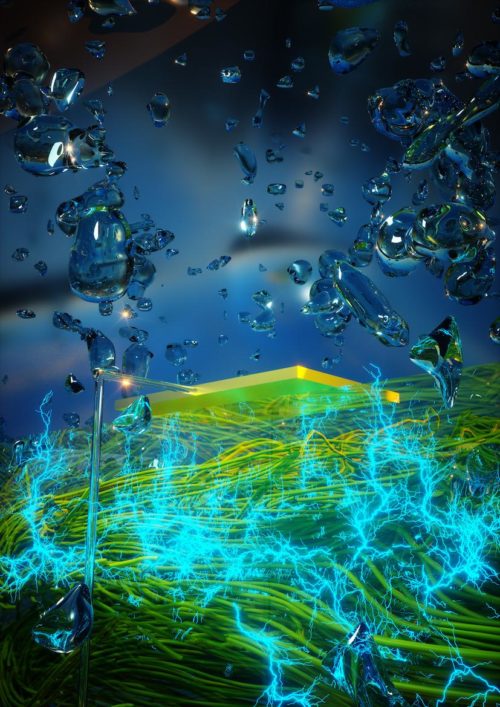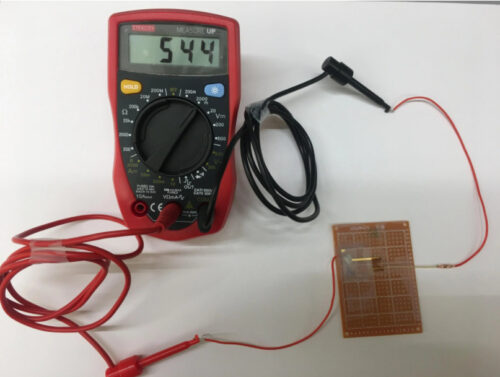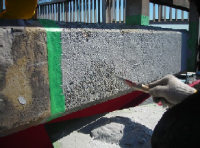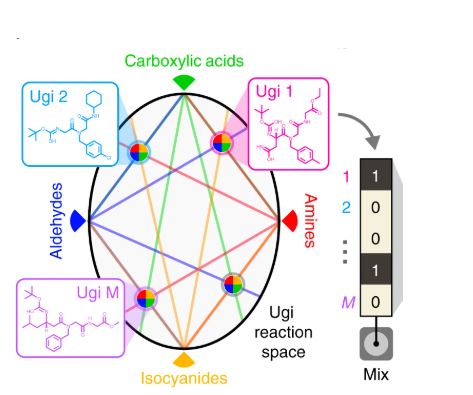(New Green Technology from UMass Amherst Generates Electricity “Out of Thin Air”)
2020-02-17 アメリカ合衆国・マサチューセッツ大学アマースト校

Graphic image of a thin film of protein nanowires generating electricity from atmospheric humidity.

The current Air-gen device can power small devices. Photos courtesy: UMass Amherst/Yao and Lovley labs.
・ マサチューセッツ大学アマースト校が、ジオバクター属微生物が生成する導電性タンパク質ナノワイヤを利用して空気中の水蒸気で発電するデバイス、「Air-gen」を開発。
・ 無公害、再生可能で低コストの同デバイスでは、サハラ砂漠のような極端に低湿度の地域や屋内での発電が可能。太陽光や風力で発電する他の再生可能エネルギーを大幅に超える利点を提供する。
・ 同デバイスは、タンパク質ナノワイヤの薄膜(10μm を下回る薄さ)の下に電極を配置し、上部のナノワイヤ薄膜の一部分をより微細な電極でカバーしたもの。同薄膜が空気中の水分を吸収し、デバイス中に電圧勾配を発生させる。タンパク質ナノワイヤの導電性と界面化学の組合せに薄膜中のナノワイヤの間の微細孔が加わることで、薄膜上部と底部の電極間で発電する条件が揃う。
・ 同デバイスでは、小型の電子機器への電力供給が可能。商業化へのスケールアップが期待できる。次の段階では、蓄電池を代替する、ヘルスモニターやスマートウォッチ等のウェアラブルに電力を供給する「パッチ」、また、携帯電話の定期的な充電を不要にするアプリケーションに向けた開発を目指す。
・ 最終的な目標は大規模なシステムの開発。例えば、ペンキに統合した家庭給電や、系統外で電力を供給するスタンドアローン型空気発電器等を想定。ナノワイヤの製造が産業スケールに達すれば、持続可能なエネルギー生産に多大に貢献する大型のシステムの開発が可能と考える。
・ ジオバクター属微生物の生体的能力のさらなる向上を目指し、大腸菌(E. coli)をタンパク質ナノワイヤの生成工場に転換し、タンパク質ナノワイヤをより迅速・安価に大量に生成する菌株を新たに開発。このスケーラブルなプロセスにより、ナノワイヤの供給の問題を解決した。
・ ジオバクター属微生物は、同デバイス研究者の一人が 30 年以上前にポトマック川(米国東部メリーランドとバージニアの州境を流れ大西洋のチェサピーク湾に注ぐ)の泥の中で発見。その後、同微生物による導電性タンパク質ナノワイヤの生成能力を発見した。
・ 本研究は、同大学の Office of Technology Commercialization and Ventures を通じたシードファンドおよび同大学の College of Natural Science による研究開発資金が一部支援した。
URL: https://www.umass.edu/newsoffice/article/new-green-technology-umass-amherst
(関連情報)
Nature 掲載論文(アブストラクトのみ:全文は有料)
Power generation from ambient humidity using protein nanowires
URL: https://www.nature.com/articles/s41586-020-2010-9
<NEDO海外技術情報より>
Abstract
Harvesting energy from the environment offers the promise of clean power for self-sustained systems1,2. Known technologies—such as solar cells, thermoelectric devices and mechanical generators—have specific environmental requirements that restrict where they can be deployed and limit their potential for continuous energy production3,4,5. The ubiquity of atmospheric moisture offers an alternative. However, existing moisture-based energy-harvesting technologies can produce only intermittent, brief (shorter than 50 seconds) bursts of power in the ambient environment, owing to the lack of a sustained conversion mechanism6,7,8,9,10,11,12. Here we show that thin-film devices made from nanometre-scale protein wires harvested from the microbe Geobacter sulfurreducens can generate continuous electric power in the ambient environment. The devices produce a sustained voltage of around 0.5 volts across a 7-micrometre-thick film, with a current density of around 17 microamperes per square centimetre. We find the driving force behind this energy generation to be a self-maintained moisture gradient that forms within the film when the film is exposed to the humidity that is naturally present in air. Connecting several devices linearly scales up the voltage and current to power electronics. Our results demonstrate the feasibility of a continuous energy-harvesting strategy that is less restricted by location or environmental conditions than other sustainable approaches.


